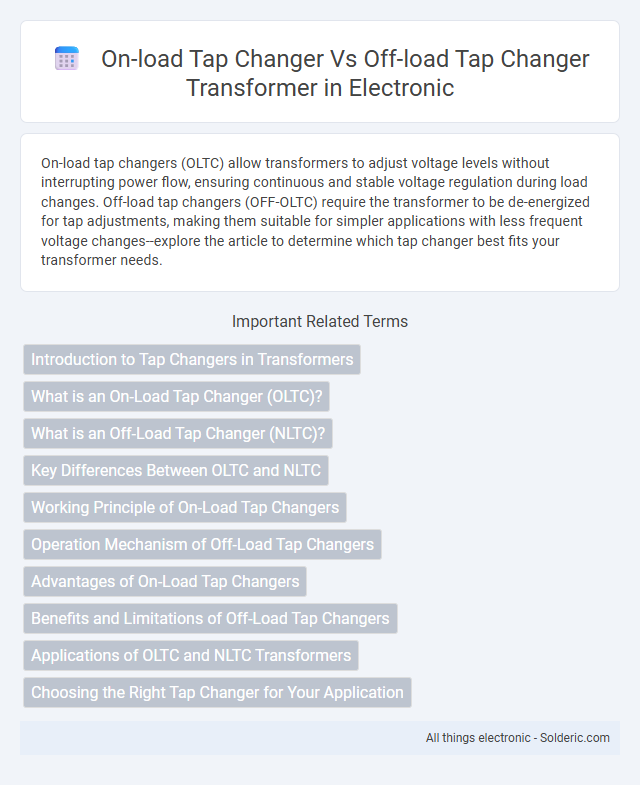On-load tap changers (OLTC) allow transformers to adjust voltage levels without interrupting power flow, ensuring continuous and stable voltage regulation during load changes. Off-load tap changers (OFF-OLTC) require the transformer to be de-energized for tap adjustments, making them suitable for simpler applications with less frequent voltage changes--explore the article to determine which tap changer best fits your transformer needs.
Comparison Table
| Feature | On-Load Tap Changer (OLTC) | Off-Load Tap Changer (OLTC) |
|---|---|---|
| Operation | Tap changing under load without interrupting power | Tap changing only when transformer is de-energized |
| Application | Voltage regulation during normal operation | Voltage adjustment during maintenance or shutdown |
| Complexity | More complex mechanism with diverter switches | Simpler design with no load switching contacts |
| Cost | Higher initial and maintenance cost | Lower cost and maintenance |
| Reliability | Requires careful maintenance for long life | Less prone to failure due to simpler design |
| Usage | Common in power transformers for voltage control | Used in distribution transformers where load switching is not critical |
Introduction to Tap Changers in Transformers
Tap changers in transformers adjust voltage levels to maintain stable output despite input fluctuations, with on-load and off-load types serving distinct functions. On-load tap changers enable voltage regulation without interrupting power flow, ensuring continuous operation in dynamic load conditions. Off-load tap changers require power shutdown for adjustments, making them suitable for less frequent voltage changes during maintenance or setup.
What is an On-Load Tap Changer (OLTC)?
An On-Load Tap Changer (OLTC) is a device within a transformer that adjusts voltage levels while the transformer remains energized, ensuring continuous power supply without interruption. Unlike Off-Load Tap Changers, OLTCs allow for voltage regulation under load conditions, which is critical for maintaining system stability and protecting sensitive equipment. Your electrical system benefits from improved voltage control and reduced outages due to the OLTC's ability to finely tune voltage on the fly.
What is an Off-Load Tap Changer (NLTC)?
An Off-Load Tap Changer (NLTC) is a transformer component designed to adjust voltage levels only when the transformer is de-energized, ensuring safe operation during maintenance or switching. Unlike On-Load Tap Changers (OLTC), NLTCs cannot change taps under load, making them suitable for applications with infrequent voltage adjustments. The NLTC enhances transformer flexibility by allowing manual or automated tap switching to maintain optimal voltage regulation during downtime.
Key Differences Between OLTC and NLTC
On-load tap changers (OLTC) allow voltage regulation while the transformer is energized, providing continuous voltage control without interrupting the power supply. Off-load tap changers (NLTC) require the transformer to be de-energized before changing taps, making them suitable only for adjustments during maintenance or outages. Your choice between OLTC and NLTC depends on whether reliable, real-time voltage regulation or simpler, less frequent tap changing fits your application.
Working Principle of On-Load Tap Changers
On-load tap changers (OLTC) adjust transformer tap positions without interrupting the power supply, allowing seamless voltage regulation under load conditions. The OLTC uses diverter switches and selector switches to momentarily parallel two adjacent taps during transition, ensuring continuous current flow while changing taps. This mechanism enhances voltage stability and system reliability, making it ideal for applications where maintaining uninterrupted power is critical for your operations.
Operation Mechanism of Off-Load Tap Changers
Off-load tap changers operate by interrupting the load current before changing transformer taps, requiring the transformer to be de-energized to avoid arcing and equipment damage. The mechanism involves manual or motor-driven switching between discrete tap positions under no-load conditions, ensuring secure and safe tap adjustments. This design is suited for applications where tap changes are infrequent and can be performed during planned outages or maintenance.
Advantages of On-Load Tap Changers
On-load tap changers (OLTC) enable voltage regulation without interrupting power supply, ensuring continuous operation and reduced downtime compared to off-load tap changers. Their ability to adjust voltage under load improves system stability and minimizes voltage fluctuations, enhancing overall power quality. Your electrical system benefits from increased reliability and efficiency with OLTCs, especially in dynamic load environments.
Benefits and Limitations of Off-Load Tap Changers
Off-load tap changer transformers offer simplicity and cost-effectiveness, making them suitable for applications where load variations are minimal and manual adjustment is acceptable. They have the limitation of requiring the transformer to be de-energized before changing taps, leading to downtime and potential service interruptions. This makes them less ideal for systems demanding continuous voltage regulation under varying load conditions.
Applications of OLTC and NLTC Transformers
On-load tap changer (OLTC) transformers are primarily used in power distribution systems requiring continuous voltage regulation under load conditions, such as in utility substations and renewable energy systems to maintain stable voltage output during fluctuating loads. Off-load tap changer (NLTC) transformers are commonly applied in industrial settings where voltage adjustments are infrequent and can be performed only when the transformer is de-energized, making them suitable for equipment with stable load profiles like motors and HVAC systems. The key application difference lies in OLTC transformers enabling real-time voltage control without interrupting service, whereas NLTC transformers provide simpler, cost-effective voltage adjustments during scheduled maintenance or downtime.
Choosing the Right Tap Changer for Your Application
Selecting the appropriate tap changer for your transformer depends on the operational requirements and load characteristics. On-load tap changers (OLTC) enable voltage regulation without interrupting power flow, making them ideal for applications requiring continuous voltage adjustment under load. Off-load tap changers (RCC) are suitable for scenarios where voltage changes occur only during no-load conditions, providing a cost-effective option for less dynamic systems with infrequent tapping.
on-load tap changer vs off-load tap changer transformer Infographic

 solderic.com
solderic.com